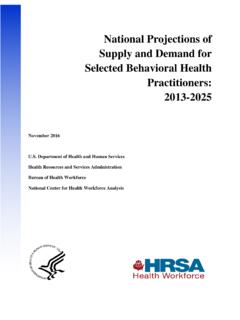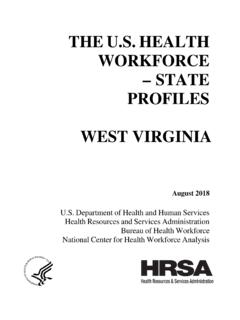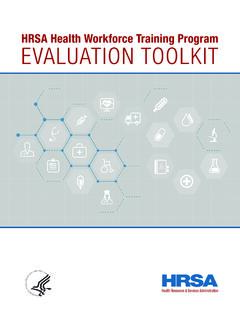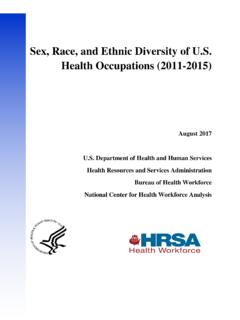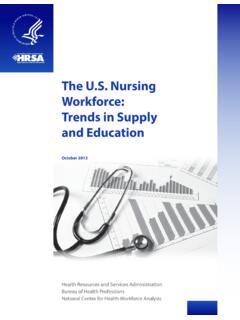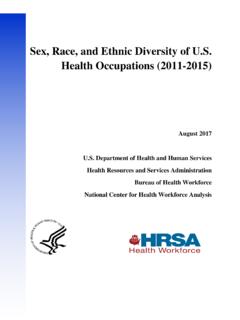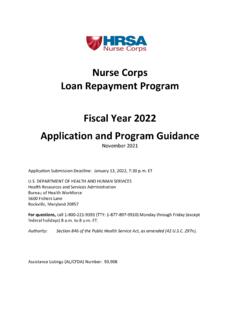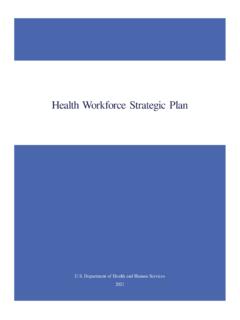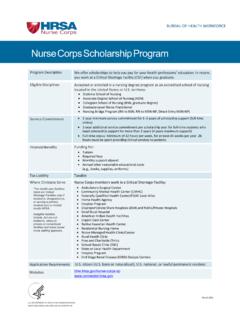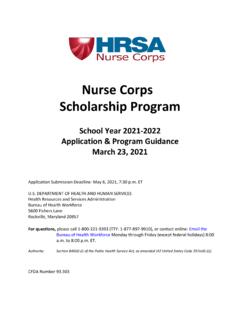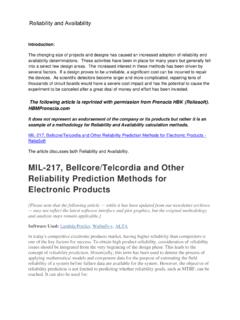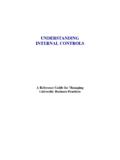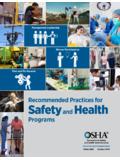Transcription of Supply and Demand Projections of the Nursing Workforce ...
1 Supply and Demand Projections of the Nursing Workforce : 2014-2030 July 21, 2017 Department of Health and Human Services Health Resources and Services Administration Bureau of Health Workforce National Center for Health Workforce Analysis About the National Center for Health Workforce Analysis The National Center for Health Workforce Analysis (the National Center) informs public and private-sector decision-making on the health Workforce by expanding and improving health Workforce data and its dissemination to the public, and by improving and updating Projections of Supply of and Demand for health workers. For more information about the National Center, please visit our website at Suggested citation: Department of Health and Human Services, Health Resources and Services Administration, National Center for Health Workforce Analysis.
2 2017. National and Regional Supply and Demand Projections of the Nursing Workforce : 2014-2030. Rockville, Maryland. Copyright information: All material appearing in this documentation is in the public domain and may be reproduced or copied without permission. Citation of the source, however, is appreciated. Supply and Demand Projections for the Nursing Workforce : 2014-2030 1 Contents 3 Key 4 Registered 4 Licensed Practical/Vocational 4 5 7 Trends in RN Supply and Demand .. 8 Exhibit 1: Baseline and Projected Supply of and Demand for Registered Nurses by State: 2014 and 2030 .. 9 Exhibit 2: RN Supply versus Demand , by State, 12 Trends in LPN Supply and Demand .
3 12 Exhibit 3: Baseline and Projected Supply of and Demand for Licensed Practical Nurses by State: 2014 and 2030 .. 13 Exhibit 4: LPN Supply versus Demand , by State, 16 Strengths and Limitations .. 16 Discussion and Conclusions .. 18 Supply and Demand Projections for the Nursing Workforce : 2014-2030 2 Supply and Demand Projections of the Nursing Workforce : 2014-2030 Overview This report presents Projections of Supply of and Demand for registered nurses (RNs) and licensed practical/vocational nurses (LPNs) in 2030, with 2014 serving as the base year. These Projections highlight the inequitable distribution of the Nursing Workforce across the United States, as recent research1,2 shows that Nursing Workforce represents a greater problem with distribution across states than magnitude at the national level.
4 Projections were developed using the Health Resources and Services Administration s (HRSA) Health Workforce Simulation Model (HWSM). The HWSM is an integrated microsimulation model that estimates current and future Supply of and Demand for health workers in multiple professions and care settings. While the nuances of modeling Supply and Demand differ for individual health professions, the basic framework remains the same. The HWSM assumes that Demand equals Supply in the base For Supply modeling, the major components (beyond common labor-market factors like unemployment) include characteristics of the existing Workforce in a given occupation; new entrants to the Workforce ( , newly trained workers); and Workforce participation decisions ( , retirement and hours worked patterns).
5 For Demand modeling, the major components include population demographics; health care use patterns (including the influence of increased insurance coverage); and Demand for health care services (translated into requirements for full-time equivalents (FTEs)).. Important limitations for these Workforce Projections include an underlying model assumption that health care delivery in the future (projected until 2030) will not change substantially from 1 Department of Health and Human Services, Health Resources and Services Administration, National Center for Health Workforce Analysis. The Future of the Nursing Workforce : National-and State-Level Projections , 2012-2025. Rockville, Maryland, 2014. 2 PI Buerhaus, DI Auerbach, DO Staiger, U Muench Projections of the long-term growth of the registered nurse Workforce : A regional analysis.
6 Nursing Economics, 2013 3 Ono T, Lafortune G, Schoenstein M. Health Workforce planning in OECD countries: a review of 26 projection models from 18 countries. OECD Health Working Papers, No. 62. France: OECD Publishing; 2013: 8-11. Supply and Demand Projections for the Nursing Workforce : 2014-2030 3 the way health care was delivered in the base year (2014) and that there will be stability in the current rates of health care utilization. In addition, the Supply model assumes that current graduation rates and Workforce participation pattern will remain unchanged in the future (2030). Changes in any of these factors may significantly impact both the Supply and Demand Projections presented in this report.
7 Alternative Supply and Demand scenarios were developed to explore the impact of such changes. A detailed description of the HWSM can be found in the accompanying technical document available at Key Findings Registered Nurses Substantial variation across states is observed for RNs in 2030 through the large differences between their projected Supply and Demand . Looking at each state s 2030 RN Supply minus its 2030 Demand reveals both shortages and surpluses in RN Workforce in 2030 across the United States. Projected differences between each state s 2030 Supply and Demand range from a shortage of 44,500 FTEs in California to a surplus of 53,700 FTEs in Florida. If the current level of health care is maintained, seven states are projected to have a shortage of RNs in 2030, with four of these states having a deficit of 10,000 or more FTEs, including California (44,500 FTEs), Texas (15,900 FTEs), New Jersey (11,400 FTEs) and South Carolina (10,400 FTEs).
8 States projected to experience the largest excess Supply compared to Demand in 2030 include Florida (53,700 FTEs) followed by Ohio (49,100 FTEs), Virginia (22,700 FTEs) and New York (18,200 FTEs). Licensed Practical/Vocational Nurses Projected changes in Supply and Demand for LPNs between 2014 and 2030 vary substantially by state. Thirty-three states are projected to experience a shortage -a smaller growth in the Supply of LPNs relative to their state-specific Demand for LPNs. States projected to experience the largest shortfalls of LPNs in 2030 include Texas, with a largest projected deficit of 33,500 FTEs, followed by Pennsylvania with a shortage of 18,700 FTEs. Supply and Demand Projections for the Nursing Workforce : 2014-2030 4 In seventeen states where projected LPN Supply exceeds projected Demand in 2030, Ohio exhibits the greatest excess Supply of 4,100 FTEs, followed by California with 3,600 excess FTEs.
9 Background Health care spending is approximately 18 percent of the economy (GDP). Nursing is the single largest profession in the entire health care Workforce with RNs and LPNs making up the two largest occupations in this RNs and LPNs perform a variety of patient care duties and are critical to the delivery of health care services across a wide array of settings, including ambulatory care clinics, hospitals, Nursing homes, public health facilities, hospice programs, and home health agencies. Distinctions are made among different types of nurses according to their education, role, and the level of autonomy in practice. LPNs typically receive training for a year beyond high school and, after passing the national NCLEX-PN exam, become licensed to work in patient care.
10 LPNs provide a variety of direct care services including administration of medication, taking medical histories, recording symptoms and vital signs, and other tasks as delegated by RNs, physicians, and other health care ,6 RNs usually have a bachelor's degree in Nursing , a two year associate s degree in Nursing , or a diploma from an approved Nursing program. They must also pass a national exam, the NCLEX-RN, before they are licensed to ,8,9 RN responsibilities involve work that is more 4 Department of Labor, Bureau of Labor Statistics. (2012). Occupational Outlook Handbook, 2012-13 Edition. Washington, : GPO, Bureau of Labor Statistics. Retrieved from ; 5 Mueller, C., Anderson, R., McConnel, E. (2012). Licensed Nurse Responsibilities in Nursing Homes: A Scope-of-Practice Issue.
